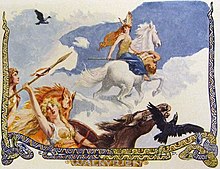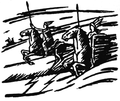List of valkyrie names

In Norse mythology, a valkyrie (from Old Norse valkyrja "chooser of the fallen") is one of a host of female figures who decide who will die in battle. Selecting among half of those who die in battle (the other half go to the goddess Freyja's afterlife field Fólkvangr), the valkyries bring their chosen to the afterlife hall of the slain, Valhalla, ruled over by the god Odin. There, when the einherjar are not preparing for the events of Ragnarök, the valkyries bear them mead. Valkyries also appear as lovers of heroes and other mortals, where they are sometimes described as the daughters of royalty, sometimes accompanied by ravens, and sometimes connected to swans.
The Old Norse poems Völuspá, Grímnismál, Darraðarljóð, and the Nafnaþulur section of the Prose Edda book Skáldskaparmál provide lists of valkyrie names. Other valkyrie names appear solely outside these lists, such as Sigrún (who is attested in the poems Helgakviða Hundingsbana I and Helgakviða Hundingsbana II). Valkyrie names commonly emphasize associations with battle and, in many cases, with the spear—a weapon heavily associated with the god Odin.[1] Scholars such as Hilda Ellis Davidson and Rudolf Simek propose that the names of the valkyries themselves contain no individuality, but are rather descriptive of the traits and nature of war-goddesses, and are possibly the descriptive creations of skalds, a type of traditional Scandinavian poet.[2]
Some valkyrie names may be descriptive of the roles and abilities of the valkyries. The valkyrie name Herja may point to an etymological connection to Hariasa, a Germanic goddess attested on a stone from 187 CE.[3] The name Herfjötur has been theorized as pointing to the ability of the valkyries to place fetters, which would connect the valkyries to the earlier Idisi.[4] The name Svipul may be descriptive of the influence the valkyries have over wyrd or ørlog—a Germanic concept of fate.[5]
Valkyrie names
| Name | Name meaning | Referred to as a valkyrie in |
|---|---|---|
| Brynhildr | "Armor battle" or "bright battle"[6] | Skáldskaparmál |
| Eir | "Peace, clemency"[7] or "help, mercy"[8] | Nafnaþulur |
| Geirahöð | Connected to the Old Norse words geirr ("spear") and höð ("battle").[9] | Appears in some manuscripts of Grímnismál in place of the valkyrie name Geirölul[9] |
| Geiravör | "Spear-vör"[9] | Nafnaþulur |
| Geirdriful | "Spear-flinger"[9] | Nafnaþulur |
| Geirönul, Geirrönul, Geirömul, Geirölul (various spellings) | Uncertain; possibly connected to the Odinic name Geirölnir and the dwarf name Ölnir.[10] Possibly meaning "the one charging forth with the spear".[10] The form Geirölul may be connected to the runic charm word alu.[10] | Grímnismál, Nafnaþulur |
| Geirskögul | "Spear-skögul"[11] (see Skögul entry below) | Hákonarmál, Völuspá, Nafnaþulur |
| Göll | "Tumult"[12] or "noise, battle"[13] | Grímnismál, Nafnaþulur |
| Göndul | "Wand-wielder"[12] | Völuspá, Nafnaþulur |
| Guðr or Gunnr | "War"[12] or "battle"[14] | Völuspá, Darraðarljóð, Gylfaginning, Nafnaþulur |
| Herfjötur | "Host-fetter"[12] or "fetter of the army"[4] | Grímnismál, Nafnaþulur |
| Herja | "Army" or "One Belonging to the Army". From Proto-Germanic "harjaz" ("army") and later Gothic "harjis", Proto-West Germanic "hari" and Proto-Norse "harja" with the same meaning "army". As a personal name of a valkyrie can't be a verb (see the rest of the list), probably during the initial transition from Proto-Norse "harja" to Old Norse "herja" the latter still meant "army" for a while. Related to the Old Norse herja and Old High German herjón (meaning "to devastate, to lay waste with the army")[15] | Nafnaþulur |
| Hlaðguðr svanhvít | "Hlaðguðr swan-white"[16] | Völundarkviða |
| Hildr | "Battle"[17] | Völuspá, Grímnismál, Darraðarljóð, Nafnaþulur |
| Hjalmþrimul | Possibly "Helmet clatterer" or "female warrior"[18] | Nafnaþulur |
| Hervör alvitr | Alvitr possibly means "all-wise" or "strange creature"[19] | Völundarkviða |
| Hjörþrimul | "The sword warrioress," derived from Old Norse hjörr ("sword") and þrima ("battle, noise")[18] | Darraðarljóð, Nafnaþulur |
| Hlökk | "Noise, battle"[12] | Grímnismál, Nafnaþulur |
| Hrist | Related to Old Norse hrista (meaning "shake, quake") and therefore meaning "the quaking one"[20] | Grímnismál, Nafnaþulur |
| Hrund | "Pricker"[12] | Nafnaþulur |
| Kára | Either "the wild, stormy one" (based on Old Norse afkárr, meaning "wild") or "curl" or "the curly one"[21] | Helgakviða Hundingsbana II |
| Mist | "Cloud" or "Mist"[22] | Grímnismál, Nafnaþulur |
| Ölrún | Possibly "ale-rune"[23] | Völundarkviða |
| Randgríðr, Randgrid | "Shield-truce"[12] or possibly "shield-destroyer"[24] | Grímnismál, Nafnaþulur |
| Ráðgríðr | "Council-truce"[12] or possibly "the bossy"[25] | Grímnismál, Nafnaþulur |
| Reginleif | "Power-trace"[12] or "daughter of the gods"[26] | Grímnismál, Nafnaþulur |
| Róta | Possibly connected to the Old Norse noun róta (meaning "sleet and storm")[27] | Gylfaginning |
| Sanngriðr | "Very violent, very cruel"[28] | Darraðarljóð |
| Sigrdrífa | "Victory-urger"[12] or "inciter to victory"[29] | Sigrdrífumál |
| Sigrún | "Victory rune"[12] | Helgakviða Hundingsbana I, Helgakviða Hundingsbana II |
| Skalmöld | "Sword-time"[30] | Nafnaþulur |
| Skeggöld or Skeggjöld | "Axe-age"[12] | Grímnismál, Nafnaþulur |
| Skögul | "Shaker"[12] or possibly "high-towering"[1] | Hákonarmál, Völuspá, Grímnismál, Nafnaþulur |
| Skuld | Possibly "debt" or "future"[31] | Völuspá, Gylfaginning, Nafnaþulur |
| Sveið | Unclear; possibly "vibration" or "noise"[32] | Nafnaþulur |
| Svipul | "Changeable"[5] | Darraðarljóð, Nafnaþulur |
| Þögn | "Silence"[33] | Nafnaþulur |
| Þrima | "Fight"[34] | Nafnaþulur |
| Þrúðr | "Strength"[35] or "power"[36] | Grímnismál, Nafnaþulur |
See also
Citations
- ^ a b Davidson (1988:96).
- ^ Examples include Davidson (1988:96–97) and Simek (2007:349).
- ^ Simek (2007:143). For Hariasa, Simek (2007:131).
- ^ a b Simek (2007:142).
- ^ a b Simek (2007:308).
- ^ For "armor battle", see Haymes (2010:27). For "bright battle", see Orchard (1997:193).
- ^ Lindow (2001:105).
- ^ Orchard (1997:36).
- ^ a b c d Simek (2007:102).
- ^ a b c Simek (2007:102–103).
- ^ Orchard (1997:193).
- ^ a b c d e f g h i j k l m Orchard (1997:194).
- ^ Simek (2007:115).
- ^ Simek (2007:125).
- ^ Simek (2007:143).
- ^ Simek (2007:151).
- ^ Orchard (1997:192).
- ^ a b Simek (2007:150).
- ^ Orchard (1997:83).
- ^ Simek (2007:160).
- ^ Simek (2007:182).
- ^ Orchard (1997:194) and Simek (2007:218).
- ^ Ochard (1997:278).
- ^ Simek (2007:261).
- ^ Simek (2007:258).
- ^ Simek (2007:262).
- ^ Vigfusson (1874:503).
- ^ Simek (2007:275).
- ^ Simek (2007:284).
- ^ Simek (2007:288).
- ^ Orchard (1997:151).
- ^ Simek (2007:306).
- ^ Simek (2007:316).
- ^ Simek (2007:328).
- ^ Lindow (2001:291).
- ^ Orchard (1997:195).
General and cited references
- Davidson, Hilda Roderick Ellis (1988). Myths and Symbols in Pagan Europe: Early Scandinavian and Celtic Religions. Manchester University Press. ISBN 0719025796
- Lindow, John (2001). Norse Mythology: A Guide to the Gods, Heroes, Rituals, and Beliefs. Oxford University Press. ISBN 0-19-515382-0
- Haymes, Edward (2010). Wagners Ring in 1848: New Translations of The Nibelung Myth and Siegfried's Death. Camden House.
- Orchard, Andy (1997). Dictionary of Norse Myth and Legend. Cassell. ISBN 0 304 34520 2
- Simek, Rudolf (2007) translated by Angela Hall. Dictionary of Northern Mythology. D.S. Brewer ISBN 0859915131
- Cleasby, Richard; Vigfússon, Guðbrandur (1878). An Icelandic-English Dictionary. Clarendon Press.

